Room Temperature Solid State Synthesis, Characterization, and Application of a Zinc Complex with Pyromellitic Acid
Abstract
:1. Introduction
2. Experimental Section
2.1. Materials and Physical Measurements
2.2. Synthesis of [Zn2(btca)(H2O)4]
2.3. Preparation of Nano-ZnO
3. Results and Discussion
3.1. Composition and Property of the Title Complex
3.2. X-ray Powder Diffraction Analysis
3.3. IR Spectroscopy Analysis
3.4. Thermogravimetric Analysis
3.5. Particle Size and Morphology of Nano-ZnO
4. Conclusions
Acknowledgments
Author Contributions
Conflicts of Interest
References
- Xia, C.-K.; Wu, F.; Yang, K.; Wu, Y.-L.; Lu, X.-J. Syntheses, crystal structures and properties of four novel zinc(II) complexes assembled from versatile 1,2,3,5-benzenetetracarboxylic acid and bridging dipyridyl ligands. Polyhedron 2016, 112, 78–85. [Google Scholar] [CrossRef]
- Wang, X.-B.; Lu, W.-G.; Zhong, D.-C. Two zinc(II) metal-organic frameworks with mixed ligands of 5-amino-tetrazolate and 1,2,4,5-benzenetetracarboxylate: Synthesis, structural diversity and photoluminescent properties. J. Solid State Chem. 2017, 250, 83–89. [Google Scholar] [CrossRef]
- Wang, Y.-F.; Li, Z.; Sun, Y.-C.; Zhao, J.-S.; Zhang, S.-C. Synthesis, characterization and crystal structures of 2D Co.(II)/Zn(II)-coordination polymers containing 3-(pyridin-4-yl)-5-(pyrazin-2-yl)-1H-1,2,4-triazole and benzenetetracarboxylate co-ligands. Inorg. Chem. Commun. 2014, 44, 25–28. [Google Scholar] [CrossRef]
- Sanda, S.; Goswami, S.; Jena, H.S.; Parshamoni, S.; Konar, S. A family of three magnetic metal organic frameworks: Their synthesis, structural, magnetic and vapour adsorption study. CrystEngComm 2014, 16, 4742–4752. [Google Scholar] [CrossRef]
- Zhao, Y.; Lu, H.; Yang, L.; Luo, G.G. Reversible adsorption of a planar cyclic (H2O)6 cluster held in a 2D CuII-coordination framework. J. Mol. Struct. 2016, 1088, 155–160. [Google Scholar] [CrossRef]
- Wang, X.-X.; Zhang, M.-X.; Yu, B.; Hecke, K.V.; Cui, G.-H. Synthesis, crystal structures, luminescence and catalytic properties of two d10 metal coordination polymers constructed from mixed ligands. Spectrochim. Acta A 2015, 139, 442–448. [Google Scholar] [CrossRef] [PubMed]
- Xia, C.; Yang, K.; Wu, F.; Lu, X.; Min, Y.; Xie, J. Syntheses and characterization of two new compounds based on versatile 1,2,3,5-benzenetetracarboxylic acid and 2,2′-bibenzimidazole. J. Coord. Chem. 2017, 70, 2510–2519. [Google Scholar] [CrossRef]
- Du, S.; Ji, C.; Xin, X.; Zhuang, M.; Yu, X.; Lu, J.; Lu, Y.; Sun, D. Syntheses, structures and characteristics of four alkaline-earth metal-organic frameworks (MOFs) based on benzene-1,2,4,5-tetracarboxylicacid and its derivative ligand. J. Mol. Struct. 2017, 1130, 565–572. [Google Scholar] [CrossRef]
- Zhong, G.-Q.; Li, D.; Zhang, Z.-P. Hydrothermal synthesis, crystal structure and magnetic property of a homodinuclear ternary coordination polymer of nickel(II). Polyhedron 2016, 111, 11–15. [Google Scholar] [CrossRef]
- Wang, G.; Ma, D.; Jia, X.; Cui, X.; Zhao, X.; Wang, Y. In situ preparation of nanometer-scale zinc oxide from zinc acetate in the reaction for the synthesis of dimethyl toluene dicarbamate and its catalytic decomposition performance. Ind. Eng. Chem. Res. 2016, 55, 8011–8017. [Google Scholar] [CrossRef]
- Lee, T.-H.; Ryu, H.; Lee, W.-J. Fast vertical growth of ZnO nanorods using a modified chemical bath deposition. J. Alloys Compd. 2014, 597, 85–90. [Google Scholar] [CrossRef]
- Kamari, H.M.; Al-Hada, N.M.; Saion, E.; Shaari, A.H.; Talib, Z.A.; Flaifel, M.H.; Ahmed, A.A.A. Calcined solution-based PVP influence on ZnO semiconductor nanoparticle properties. Crystals 2017, 7, 2. [Google Scholar] [CrossRef]
- Hussain, S.; Liu, T.; Kashif, M.; Cao, S.; Zeng, W.; Xu, S.; Naseer, K.; Hashim, U. A simple preparation of ZnO nanocones and exposure to formaldehyde. Mater. Lett. 2014, 128, 35–38. [Google Scholar] [CrossRef]
- Thilagavathi, T.; Geetha, D. Nano ZnO structures synthesized in presence of anionic and cationic surfactant under hydrothermal process. Appl. Nanosci. 2014, 4, 127–132. [Google Scholar] [CrossRef]
- Zhong, G.-Q.; Zhong, Q. Solid-solid synthesis, characterization, thermal decomposition and antibacterial activities of zinc(II) and nickel(II) complexes of glycine-vanillin Schiff base ligand. Green Chem. Lett. Rev. 2014, 7, 236–242. [Google Scholar] [CrossRef]
- Li, D.; Zhong, G.-Q.; Wu, Z.-X. Solid-solid synthesis, characterization and thermal decomposition of a homodinuclear cobalt(II) complex. J. Serb. Chem. Soc. 2015, 80, 1391–1397. [Google Scholar] [CrossRef]
- Tai, X.-S.; Meng, Q.-G.; Liu, L.-L. Synthesis, crystal structure, and cytotoxic activity of a novel eight-coordinated dinuclear Ca(II)-Schiff base complex. Crystals 2016, 6, 109. [Google Scholar] [CrossRef]
- Nakamoto, K. Infrared and Raman Spectra of Inorganic and Coordination Compounds, 6th ed.; John Wiley & Sons Inc.: Hoboken, NJ, USA, 2009. [Google Scholar]
- Majumder, A.; Gramlich, V.; Rosair, G.M.; Batten, S.R.; Masuda, J.D.; El Fallah, M.S.; Ribas, J.; Sutter, J.P.; Desplanches, C.; Mitra, S. Five new cobalt(II) and copper(II)-1,2,4,5-benzenetetracarboxylate supramolecular architectures: Syntheses, structures, and magnetic properties. Cryst. Growth Des. 2006, 6, 2355–2368. [Google Scholar] [CrossRef]
- Lei, R.; Zhang, H.-H.; Hu, J.; Chai, X.-C.; Zhang, S.; Li, C.-X.; Chen, Y.-P.; Sun, Y.-Q. Synthesis and single-crystal structure of a silver(I) carboxyarylphosphonate: [Ag(H2BCP)(4,4′-bipy)]·2H2O. Chin. J. Struct. Chem. 2010, 29, 655–659. [Google Scholar]
- Tai, X.S.; You, H.Y. A new 1D chained coordination polymer: Synthesis, crystal structure, antitumor activity and luminescent property. Crystals 2015, 5, 608–616. [Google Scholar] [CrossRef]
- Bahnasawy, R.M.E.; El-Tabl, A.S.; Shakdofa, M.M.E.; El-Wahed, N.M.A. Cu(II), Ni(II), Co.(II), Mn(II), Zn(II) and Cd(II) complexes of ethyl-3-(2-carbamothioylhydrazono)-2-(hydroxyimino)butanoate: Synthesis, characterization and cytotoxicity activity. Chin. J. Inorg. Chem. 2014, 30, 1435–1450. [Google Scholar]
- Zhong, G.Q.; Shen, J.; Jiang, Q.Y.; Jia, Y.Q.; Chen, M.J.; Zhang, Z.P. Synthesis, characterization and thermal decomposition of SbIII–M–SbIII type trinuclear complexes of ethylenediamine-N,N,N′,N′-tetraacetate (M:Co(II), La(III), Nd(III), Dy(III)). J. Therm. Anal. Calorim. 2008, 92, 607–616. [Google Scholar] [CrossRef]
- Deacon, G.B.; Phillips, R.J. Relationships between the carbon-oxygen stretching frequencies of carboxylato complexes and the type of carboxylate coordination. Coord. Chem. Rev. 1980, 33, 227–250. [Google Scholar] [CrossRef]
- Langford, J.I. A rapid method for analysing the breadths of diffraction and spectral lines using the Voigt function. J. Appl. Cryst. 1978, 11, 10–14. [Google Scholar] [CrossRef]

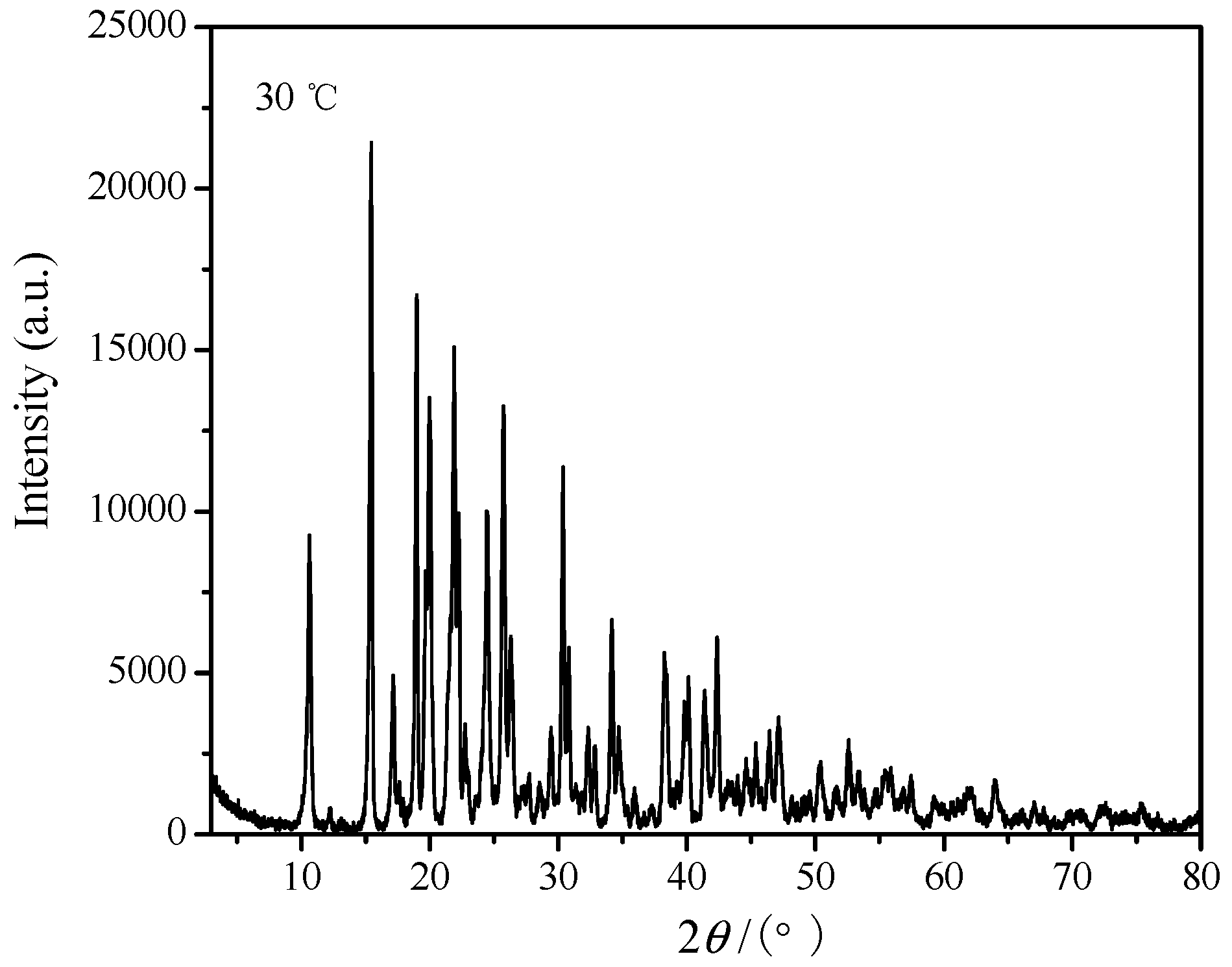
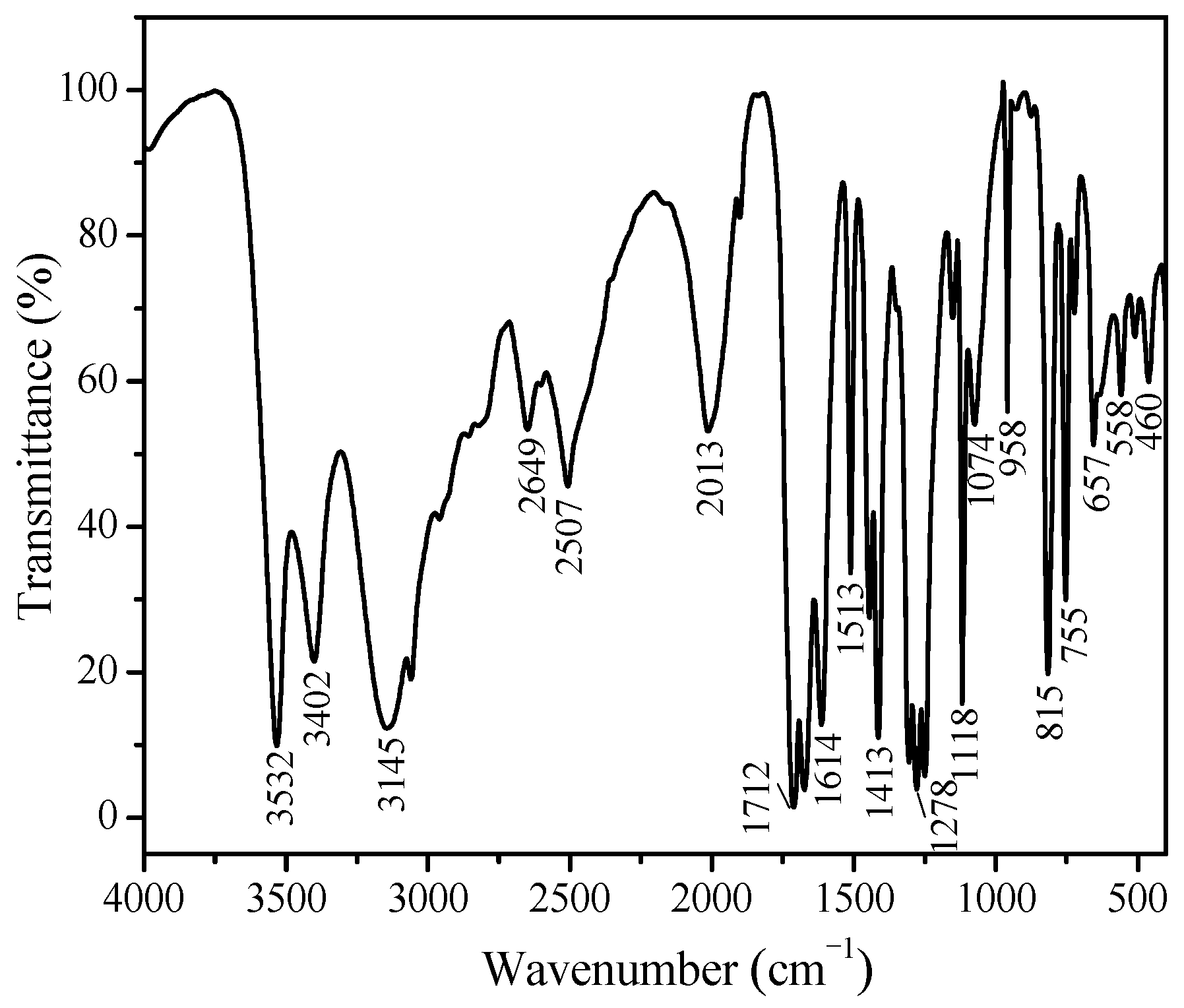
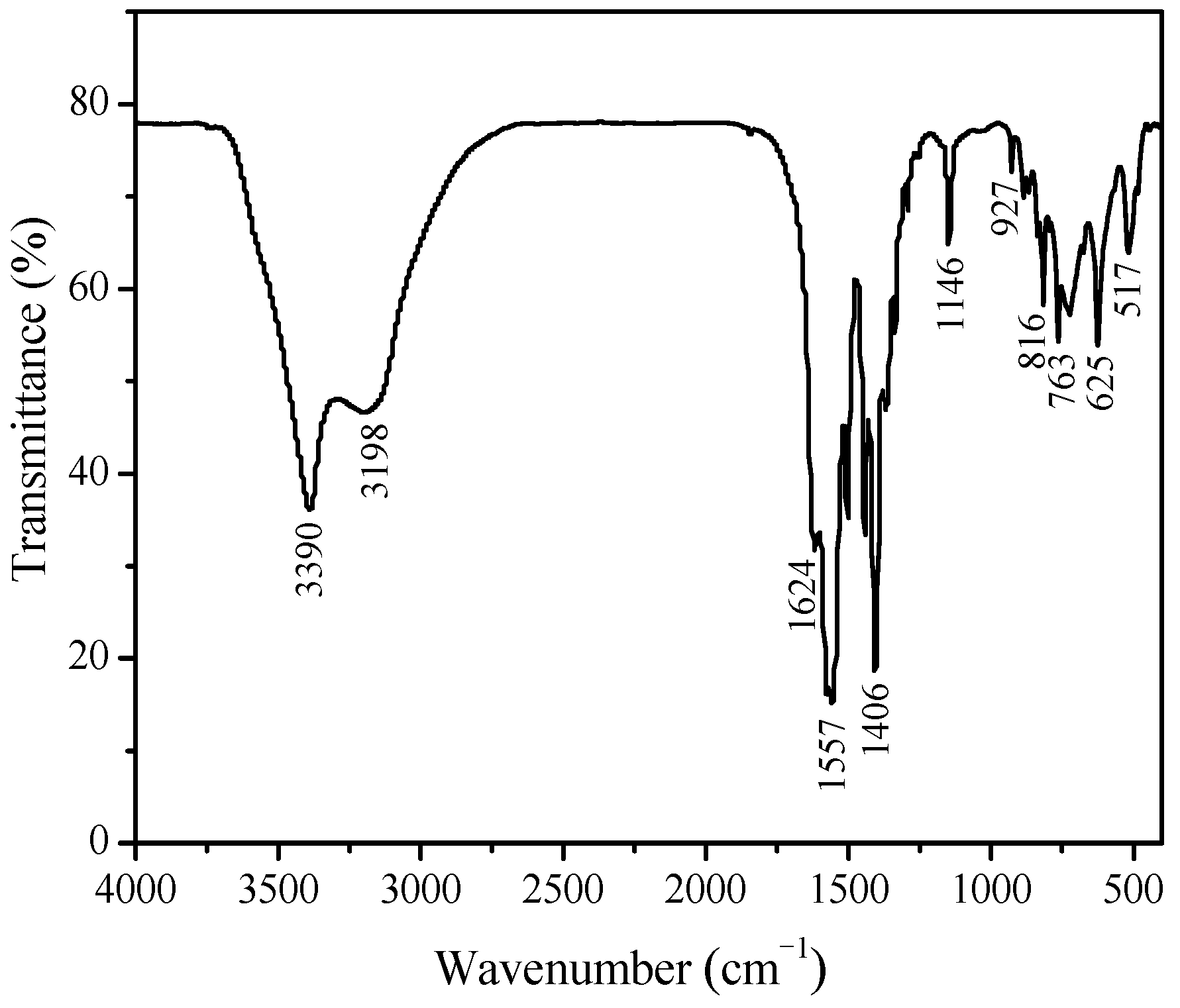
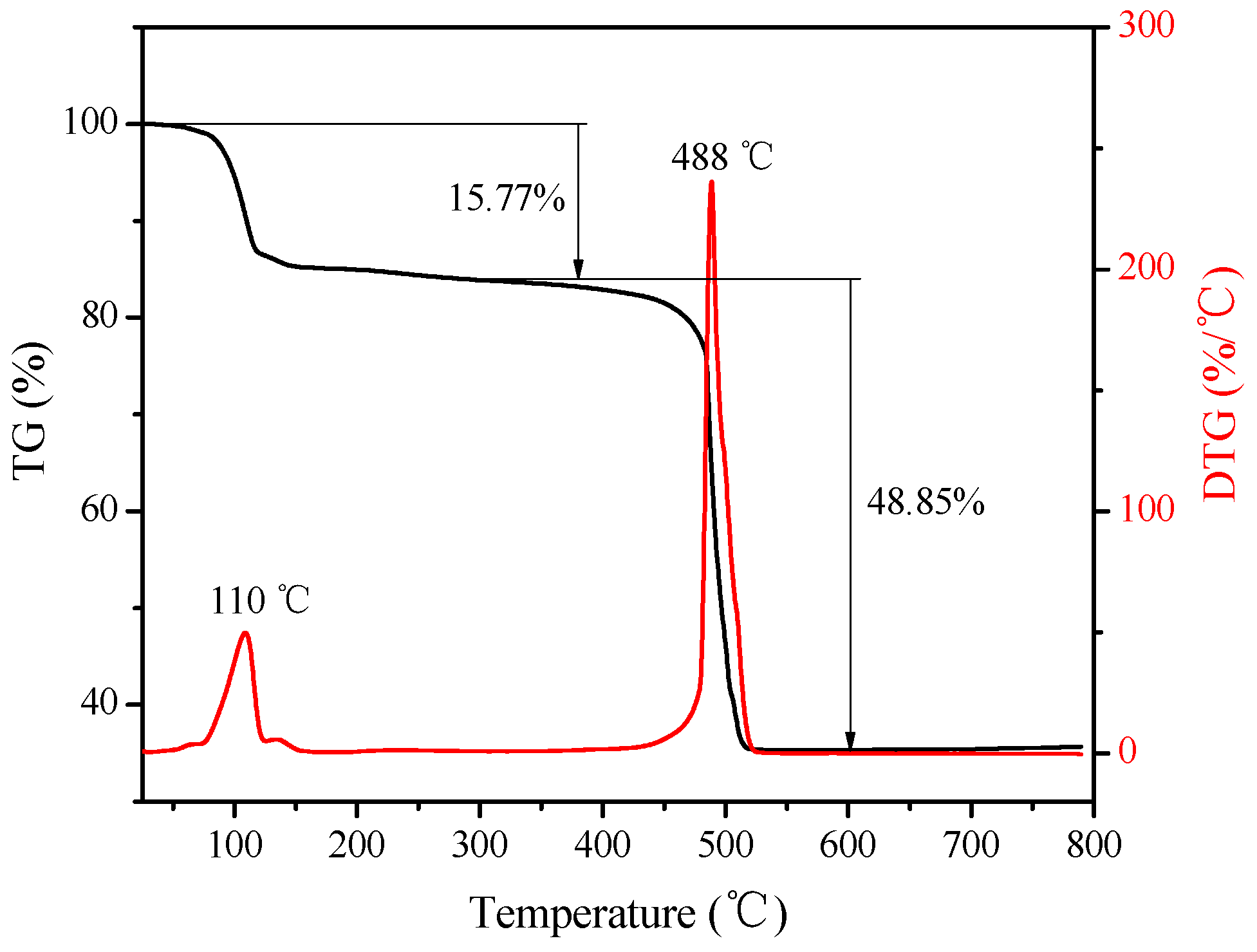
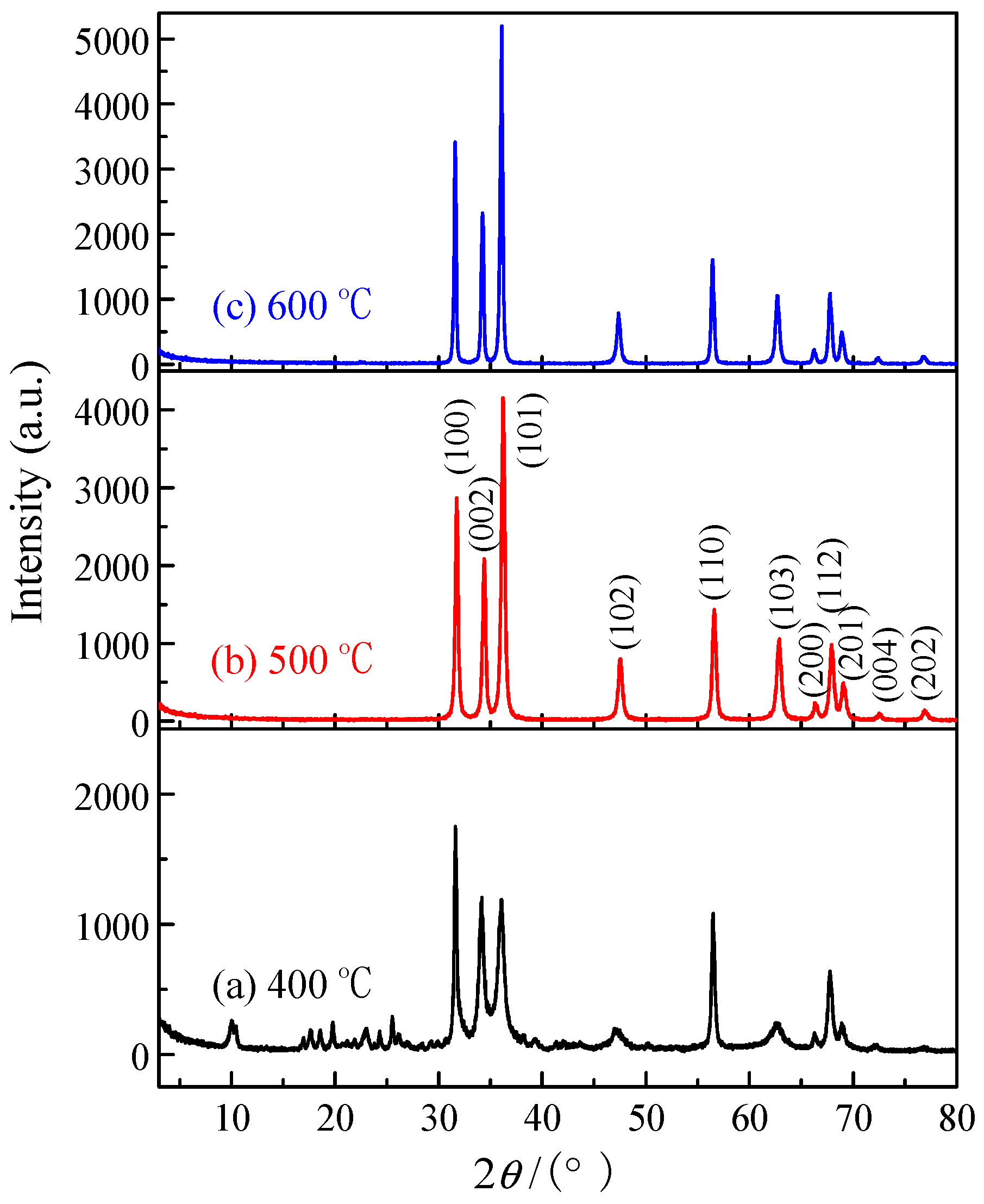
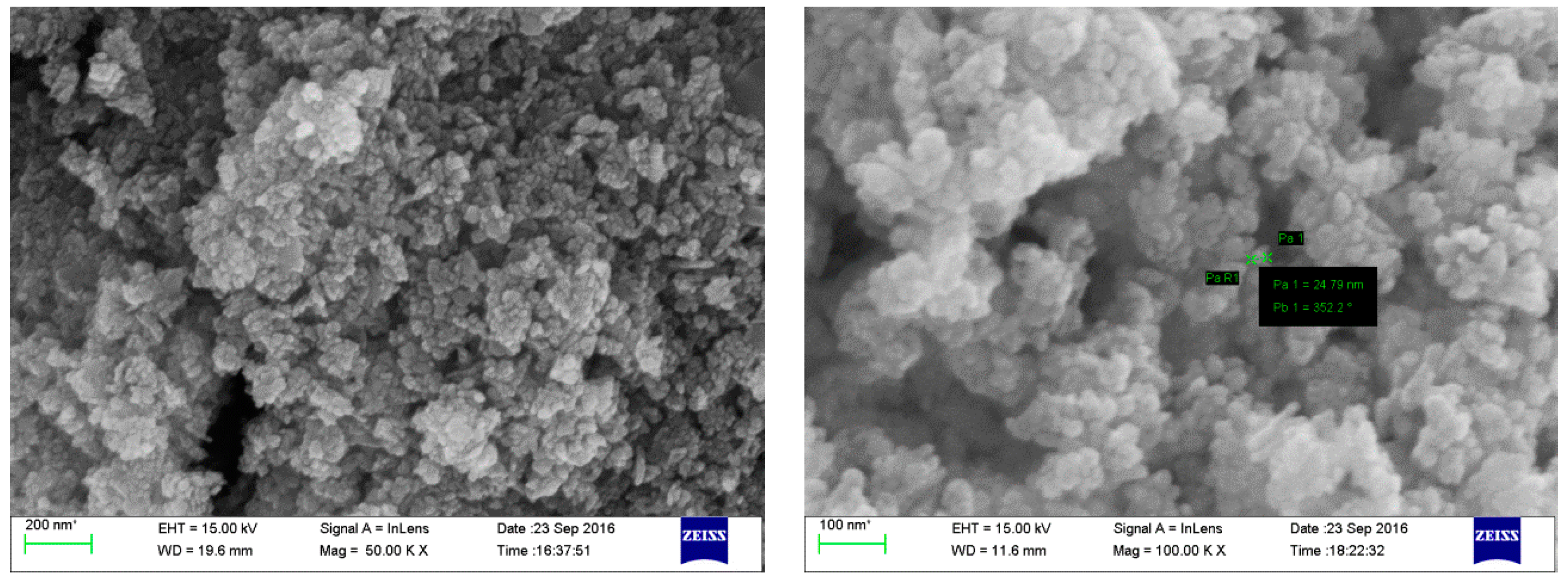
| No. | 2θ/° | h | k | l | dexp/Å | dcal/Å | I/I0 | No. | 2θ/° | h | k | l | dexp/Å | dcal/Å | I/I0 |
|---|---|---|---|---|---|---|---|---|---|---|---|---|---|---|---|
| 1 | 10.64 | 1 | 1 | −1 | 8.308 | 8.300 | 42.4 | 29 | 39.80 | 1 | 7 | 4 | 2.263 | 2.263 | 15.6 |
| 2 | 15.44 | 1 | 3 | 0 | 5.734 | 5.733 | 100.0 | 30 | 40.14 | 2 | 4 | −6 | 2.245 | 2.245 | 20.2 |
| 3 | 17.14 | 0 | 0 | 3 | 5.169 | 5.158 | 21.9 | 31 | 41.40 | 1 | 7 | −5 | 2.179 | 2.179 | 18.2 |
| 4 | 17.61 | 0 | 4 | 1 | 5.034 | 5.037 | 5.9 | 32 | 42.36 | 2 | 9 | −1 | 2.132 | 2.132 | 23.5 |
| 5 | 17.92 | 1 | 0 | −3 | 4.946 | 4.951 | 3.5 | 33 | 43.26 | 1 | 8 | 4 | 2.090 | 2.093 | 3.5 |
| 6 | 18.98 | 1 | 4 | 0 | 4.672 | 4.671 | 77.1 | 34 | 43.52 | 2 | 2 | 6 | 2.078 | 2.080 | 3.6 |
| 7 | 19.68 | 2 | 0 | −2 | 4.507 | 4.506 | 34.4 | 35 | 43.96 | 3 | 8 | 0 | 2.058 | 2.057 | 4.2 |
| 8 | 19.98 | 2 | 2 | −1 | 4.440 | 4.451 | 61.4 | 36 | 44.62 | 4 | 6 | −1 | 2.029 | 2.028 | 6.7 |
| 9 | 21.54 | 0 | 5 | 1 | 4.122 | 4.109 | 25.1 | 37 | 44.90 | 1 | 9 | −4 | 2.017 | 2.017 | 3.6 |
| 10 | 21.88 | 1 | 3 | −3 | 4.059 | 4.062 | 68.8 | 38 | 45.36 | 2 | 6 | 5 | 1.998 | 1.997 | 9.0 |
| 11 | 22.22 | 2 | 3 | 0 | 3.997 | 4.008 | 44.1 | 39 | 46.44 | 4 | 5 | 2 | 1.954 | 1.957 | 9.9 |
| 12 | 22.74 | 1 | 5 | 0 | 3.907 | 3.903 | 13.6 | 40 | 47.16 | 0 | 1 | 8 | 1.926 | 1.926 | 14.8 |
| 13 | 22.98 | 0 | 0 | 4 | 3.867 | 3.868 | 6.8 | 41 | 48.16 | 3 | 6 | −6 | 1.888 | 1.888 | 3.2 |
| 14 | 24.44 | 1 | 3 | 3 | 3.639 | 3.641 | 42.4 | 42 | 49.58 | 3 | 8 | 3 | 1.837 | 1.837 | 3.5 |
| 15 | 25.72 | 0 | 6 | −1 | 3.461 | 3.462 | 58.0 | 43 | 50.40 | 3 | 9 | 5 | 1.809 | 1.809 | 7.7 |
| 16 | 26.32 | 1 | 3 | −4 | 3.383 | 3.383 | 24.4 | 44 | 51.54 | 4 | 8 | −3 | 1.772 | 1.772 | 3.2 |
| 17 | 27.24 | 0 | 5 | 3 | 3.271 | 3.285 | 3.7 | 45 | 52.60 | 2 | 7 | 6 | 1.739 | 1.740 | 9.9 |
| 18 | 27.74 | 2 | 5 | −1 | 3.213 | 3.216 | 6.2 | 46 | 53.46 | 0 | 1 | 9 | 1.713 | 1.714 | 4.9 |
| 19 | 28.54 | 1 | 0 | −5 | 3.125 | 3.121 | 4.6 | 47 | 55.40 | 5 | 7 | −1 | 1.657 | 1.656 | 5.2 |
| 20 | 29.44 | 3 | 1 | 1 | 3.032 | 3.026 | 11.2 | 48 | 55.88 | 3 | 9 | 4 | 1.644 | 1.644 | 5.3 |
| 21 | 30.38 | 3 | 2 | 1 | 2.940 | 2.938 | 48.5 | 49 | 56.84 | 4 | 1 | 6 | 1.618 | 1.619 | 3.1 |
| 22 | 30.82 | 1 | 7 | 0 | 2.899 | 2.905 | 22.2 | 50 | 57.46 | 2 | 7 | 7 | 1.603 | 1.602 | 7.1 |
| 23 | 32.34 | 3 | 3 | −3 | 2.766 | 2.767 | 14.1 | 51 | 59.22 | 1 | 9 | 7 | 1.559 | 1.560 | 3.5 |
| 24 | 32.86 | 1 | 6 | 3 | 2.723 | 2.723 | 11.4 | 52 | 61.82 | 2 | 3 | 9 | 1.500 | 1.499 | 3.6 |
| 25 | 34.18 | 0 | 7 | −3 | 2.621 | 2.622 | 29.9 | 53 | 62.16 | 5 | 7 | −6 | 1.492 | 1.492 | 3.4 |
| 26 | 34.70 | 2 | 5 | 3 | 2.583 | 2.583 | 13.5 | 54 | 63.96 | 6 | 2 | 3 | 1.454 | 1.455 | 6.3 |
| 27 | 35.92 | 0 | 5 | 5 | 2.498 | 2.504 | 5.3 | 55 | 67.04 | 7 | 2 | −3 | 1.395 | 1.395 | 3.3 |
| 28 | 38.26 | 1 | 4 | −6 | 2.350 | 2.348 | 25.0 | 56 | 72.60 | 5 | 4 | 7 | 1.301 | 1.300 | 3.1 |
© 2018 by the authors. Licensee MDPI, Basel, Switzerland. This article is an open access article distributed under the terms and conditions of the Creative Commons Attribution (CC BY) license (http://creativecommons.org/licenses/by/4.0/).
Share and Cite
Yang, R.-G.; Wang, M.-L.; Liu, T.; Zhong, G.-Q. Room Temperature Solid State Synthesis, Characterization, and Application of a Zinc Complex with Pyromellitic Acid. Crystals 2018, 8, 56. https://doi.org/10.3390/cryst8020056
Yang R-G, Wang M-L, Liu T, Zhong G-Q. Room Temperature Solid State Synthesis, Characterization, and Application of a Zinc Complex with Pyromellitic Acid. Crystals. 2018; 8(2):56. https://doi.org/10.3390/cryst8020056
Chicago/Turabian StyleYang, Rong-Gui, Mei-Ling Wang, Ting Liu, and Guo-Qing Zhong. 2018. "Room Temperature Solid State Synthesis, Characterization, and Application of a Zinc Complex with Pyromellitic Acid" Crystals 8, no. 2: 56. https://doi.org/10.3390/cryst8020056





